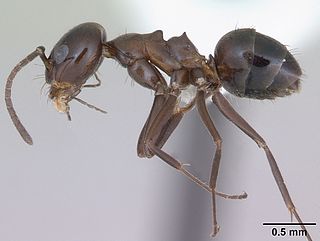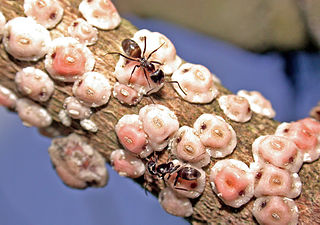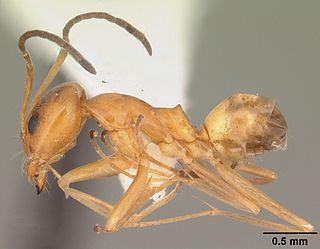
Dolichoderinae is a subfamily of ants, which includes species such as the Argentine ant, the erratic ant, the odorous house ant, and the cone ant. The subfamily presents a great diversity of species throughout the world, distributed in different biogeographic regions, from the Palearctic, Nearctic, Afrotropical region and Malaysia, to the Middle East, Australian, and Neotropical regions.

Amyrmex golbachi is a rare Neotropical species of ant and the only known species in the genus Amyrmex. It is currently only known from males from the Amazon basin of Brazil and from northern Argentina.

Dorymyrmex insanus is a species of pyramid ant, one of several species known as crazy ants, for their "frenetic" movement and swarming behavior. It is found in hot, dry habitats in the southern parts of the United States, much of Central America, and tropical South America. Dorymyrmex insanus is listed as Vulnerable by the International Union for Conservation of Nature (IUCN).

Gracilidris is a genus of dolichoderine ants with nocturnal behaviour; thought to have gone extinct 15-20 million years ago, they have been found in Paraguay, Brazil, and Argentina and were described in 2006.

Forelius is a Neotropical genus of ants in the subfamily Dolichoderinae. The genus is known from southern United States to Argentina.
Dorymyrmex amazonicus is a Neotropical species of ant in the subfamily Dolichoderinae.

Dorymyrmex bicolor is a species of ant in the Dolichoderinae subfamily. Dorymyrmex bicolor was recently known as Conomyrma bicolor but has been renamed to Dorymyrmex bicolor. Dorymyrmex bicolor has a single petiole and a slit-like orifice which releases chemical compounds. This ant does not have the capability to sting. Dorymyrmex bicolor is primarily found in arid desert regions in Central and South America and the southwestern United States.

Leptomyrmecini is a tribe of Dolichoderinae ants with 16 genera and two extinct genera.

Gracilidris pombero is a species of ant in the genus Gracilidris. Described by Wild and Cuezzo in 2006, the species is endemic to the South American countries of Argentina, Brazil and Paraguay.

Dorymyrmex biconis is a species of ant in the genus Dorymyrmex. Described by Forel in 1912, the species is endemic to Colombia and Venezuela.

Dorymyrmex bituber is a species of ant in the genus Dorymyrmex. Described by Santschi in 1916, the species is endemic to Argentina and Paraguay.

Dorymyrmex brunneus is a species of ant in the genus Dorymyrmex. Described by Forel in 1908, the species is endemic to several nations in South America.

Dorymyrmex bureni also known as pyramid ant is a species of ant in the genus Dorymyrmex. Described by Trager in 1988, the species is endemic to the United States and Mexico. Pyramid ants are medium-sized ants, ranging from 2–4 mm. They are light orange in color and fast moving. Unlike other ants in the area like red imported fire ants, this species is not aggressive towards humans. The workers have a foul smelling coconut odor when crushed. Dorymyrmex bureni hunt living insects, even other winged ants. They also search for sap-sucking insects from which they collect honeydew. On the head of these ants are curved hairs, used for transporting beads of damp sand. Colonies are small. Nests usually have a single entrance with a mound of sand shaped like a crater. Dorymyrmex bureni prefer sandy soil. This species of ant is not an indoor pest, and pesticides should not be used. They are found throughout Florida.
Dorymyrmex chilensis is a species of ant in the genus Dorymyrmex. Described by Forel in 1911, the species is endemic to Chile.

Dorymyrmex flavus is a species of ant in the genus Dorymyrmex. Described by McCook in 1879, the species is endemic to the United States and Mexico.

Dorymyrmex lipan is a species of ant in the genus Dorymyrmex. Described by Snelling in 1995, the species is endemic to the United States and Mexico.

Dorymyrmex paiute is a species of ant in the genus Dorymyrmex. Described by Snelling in 1995, the species is endemic to the United States.

Dorymyrmex paranensis is a species of ant in the genus Dorymyrmex. Described by Santschi in 1922, the species is endemic to Paraguay.
Dorymyrmex tuberosus is a species of ant in the genus Dorymyrmex. Described by Cuezzo and Guerrero in 2011, the species is endemic to Colombia.

















